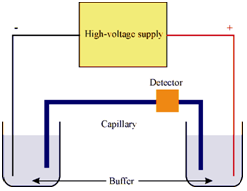Capillary Electrophoresis:
Capillary electrophoresis is a more sensitive method and along with the same principle, it could detect samples as small as few nL. Besides being more sensitive, this separation methods has high-speed and high resolution. Alternatively of staining of the samples as in slab electrophoresis, there is one quantitative detector at the end of the capillary. The capillary could also be filled with a gel, that eliminates the electroosmotic flow (vide infra). Therefore, the separation is accomplished as in conventional gel electrophoresis but the capillary permitted higher resolution, greater sensitivity and on-line detection.
A buffer filled fused silica capillary which is classically 10 to 100 µm in internal diameter and 40 to 100 cm long, extends among two buffer reservoirs which also contain platinum electrodes. Sample introduction is performed at one end and the detection at the other. The polarity of the high-voltage power supply could be as implies in Figure or can be reversed to permit rapid separation of anions. While the instrumentation is conceptually simple, there are significant experimental difficulties within the sample introduction and detection because of the extremely small volume included. Since the volume of a normal capillary is 4-5 µL, injection and detection volumes must be of the sequence of a few nano litres or less.
Let us now study more about sample introduction and detection.

Figure: A schematic representation for capillary electrophoresis